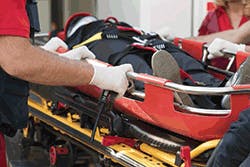One usual goal in a fatality investigation is to assemble enough information to figure out what went wrong, something so wrong that some poor soul didn't live through the workday. The usual process includes interviewing eyewitnesses and anyone else who might have information.
Throughout 25+ years of taking witness statements, both in my time with OSHA and with Lockton Companies, one contributing cause clearly has been apparent in every fatal accident: a lack of imagination. I'm not talking about blaming some individual, and certainly not the deceased person. It's more of a collective failure to consider the consequences.
On the prevention side, it's not an easy cause to eliminate.
A fatality changes everything at almost every workplace, at least temporarily. Usually, productive work grinds to a halt and the atmosphere becomes somber. (There were a few rare exceptions, mainly sweatshops where work never stops, but in normal cases, everything stopped.) The employer usually would give me an empty office or a conference room and line their people up to tell what they knew. We would trace back from the fatal accident and assemble the chain of events that led to the death.
Someone climbs into an industrial meat grinder to clean it on the inside, it's not locked out, another person wants to operate the one next to it, the switches are all on the same panel, the wrong button gets pushed, etc. Everything is done the usual way, and yet this time, someone dies doing it.
Considering someone cleans the meat grinder daily, nobody ever uses a lockout, the other machines around it are used frequently and the controls aren't labeled, the danger is all there, brightly illuminated in 20/20 hindsight. I often have found this in companies with safety training, rules, enforcement, posters, incentives and safety professionals. If only someone could have noticed this obviously risky situation BEFORE the accident that cost a life. But nobody thought it would happen that way, and a worker will never return home as a result.
It took me a while to notice, but in every single case, there always would be at least one person who would explain how nobody expected the fatal accident. Somebody would say something like, "We always do the job this way, but we never thought this would happen!" or, "We never imagined it could get somebody killed!"
At first I thought, "Of course you didn't think it would get somebody killed, because if you had, you would have stopped this immediately!" Later, though, I started to understand the nuance.
Lack of Imagination
The witnesses were talking about a legitimate contributing cause: a lack of imagination. Most people are imaginative enough to think through the risks of a process, but if not, there are many formal methods for figuring out the "what-if" scenarios.
Someone could have looked at the facts leading up to the accident and imagined the possible accident scenarios and thought: "Hmm, what could go wrong here?" We know from experience if something can go wrong, eventually it will. If a mistake is possible, someone eventually will make it. And when the stakes are as high as death, any risk is unacceptable, right?
The elements that lead to fatalities were obvious in every case I examined. But somehow, there was a tuning-out process that prevented serious consideration of risks that seemed so obvious after the accident. Here's why: Intelligent animals, including people, have the capacity to consider the risks of their actions, but also have a powerful ability to ignore risks in the pursuit of an important goal.
If this were not the case, then back in the Stone Age, we Homo sapiens never would have left the safety of our caves after seeing the first brave cave person venture out only to be devoured by a sabertooth tiger. Once we knew that awful thing could happen, we would have stayed in our caves and starved. Luckily for the survival of our species, we have the ability to consider risks and immediately ignore them.
This is why almost every one of us does something daily that is well known to have racked up a whopping 33,000 deaths last year in the United States, far more than the total of all occupational deaths: driving motor vehicles. A lot of us would never dream of bungee jumping, or playing golf in a thunderstorm, or climbing into an unprotected trench. Yet we hop into our cars without even thinking about the 33,000 people who went to their graves last year doing the same thing. We tune out the risk because we need to accomplish something we can't do without ignoring the risk. We can't just stay in our caves and starve.
I think this may be the explanation for lack of imagination being a factor in every fatal workplace accident I ever examined. Maybe someone did imagine the risk, but the focus on important goals quickly shut those thoughts down before the mind reached the "this is going to get someone killed, so we can't do it" stage. The important goals were keeping the supervisor happy, doing the job the way the supervisor wanted, getting the job done on time, etc., and the risks that went with meeting the goals were ignored. The challenge, then, is to overcome the inner voice that says it's ok to take a risk, even if in some particular scenario it could get us killed.
What Motivates Change?
Can more safety training do it? Nope. Look at tobacco sales over the last 40 years, where a massive effort educated the public on the dangers of smoking. Even with all of the warnings about cancer and the health impact of secondhand smoke, smoking rates didn't change much until stiff tax increases and widespread smoking bans changed the focus from risk education to simply making it too expensive and difficult to smoke.
The old school position on motivation is this: if they won't follow the rules, you need to do more to enforce them. At OSHA, we were trained to look for proof that a company was enforcing its rules. In particular, we were expected to look for progressive enforcement schemes.
If a company had a system where the first safety infraction was punished with a verbal warning, the second with a written warning and the third with a harsher punishment such as a day of suspension without pay, the system fit the image of what we were hoping to find. We also would look for documents that showed employees had been trained.
We didn't look for much else, such as how the company motivated its supervisors to pay attention to how employees are doing their work, or how the supervisors verified employee understanding of the training topic. We just wanted to see a paper saying employees were trained and punished if they didn't follow their training, and we moved on.
This "all stick, no carrot" philosophy is actually written into an OSHA regulation or two. For example, the lockout/tagout regulation says lockout procedures specifically must be outlined and include "the means to enforce compliance," but says nothing about how to motivate employees to follow the lockout procedures.
Considering that many tasks requiring lockout/tagout are done by employees working alone and with little supervision, this is putting all the eggs into the enforcement basket. Later, the regulation mentions retraining is mandatory "whenever the employer has reason to believe that there are deviations from or inadequacies in the employee's knowledge or use of the energy control procedure."
A similarly worded rule is included in the permit-required confined spaces regulations. Training and some sort of enforcement, at least on paper, commonly are seen in safety programs, even the ones that don't produce good results. It might keep OSHA happy, but it doesn't address the human ability to ignore risk to accomplish a goal.
This also explains why offering an incentive prize for an injury-free month doesn't accomplish much. Once people have tuned out risks, they no longer imagine they are going to get hurt doing whatever risky things they need to do to quickly accomplish their goals. They don't see those risks as obstacles to getting the prize, so they keep taking the risks and keep getting hurt. You can dangle all the prizes you want, but it won't make a meaningful, permanent change if there is no system to overcome our ability to ignore risk.
The Good News
The good news is we know some fundamentals about workplaces that we can use to our advantage. At work, we know people generally will do what they understand to be important to their immediate supervisors and not much else; and we know training generally is NOT the way people figure out what's important to their immediate supervisors.
Simply training people and turning them loose has been shown to be a waste of time if the goal is to show employees what's important in their jobs. When we use weak, hands-off training methods, such as tossing on a generic DVD or online video, it's even more of a waste. Waiting around for a safety violation to come to our attention, then jumping on the worker also is not a good use of our time if we don't spend much time pushing safety through positive means.
Supervisors can't abdicate the safety aspects of their duties, because the safety training, posters and incentive programs we might hope would motivate people don't. None of them are the equivalent of putting safety on autopilot. Supervisors must show safety is an important, non-optional part of their expectations, and make sure employees aren't just trained but fully understand the safety aspects of their work – not just how, but why they will want to consistently work safely.
When we identify the important hazards of a task, come up with effective ways to control or eliminate those hazards and get our supervisors to motivate everyone to comply with whatever safety measures we've come up with, we prevent accidents. But we just can't train supervisors and let them go. We need to motivate them to spend some of their energies on supervising safety. The good news is there is a treasure trove of powerful management tools at our disposal, proven to be vital to getting things done.
We can use individual goals, performance reviews, supervisory leadership, mentoring, positive motivation, leading indicator metrics, accountability systems and good old management. These are elements not always seen applied to safety, but which commonly have been used to achieve the best possible results in other important areas such as productivity, efficiency and quality.
We can require supervisors and other floor-level leaders to do some documented task safety observations, which are spot-checks to see how employees are accomplishing their tasks, or other promotional, short-term assignments that raise the emphasis on safety. These proven tools have enough power to override our natural ability to take risk, and to prevent fatal accidents. If we put some of these in place, or come up with other effective accountability methods that drive supervisors to put more motivating emphasis on safety, we will get better results – in spite of a lack of imagination.
William H. Kincaid, P.E., CSP, CET, is vice president and senior loss control consultant for Lockton Companies.

